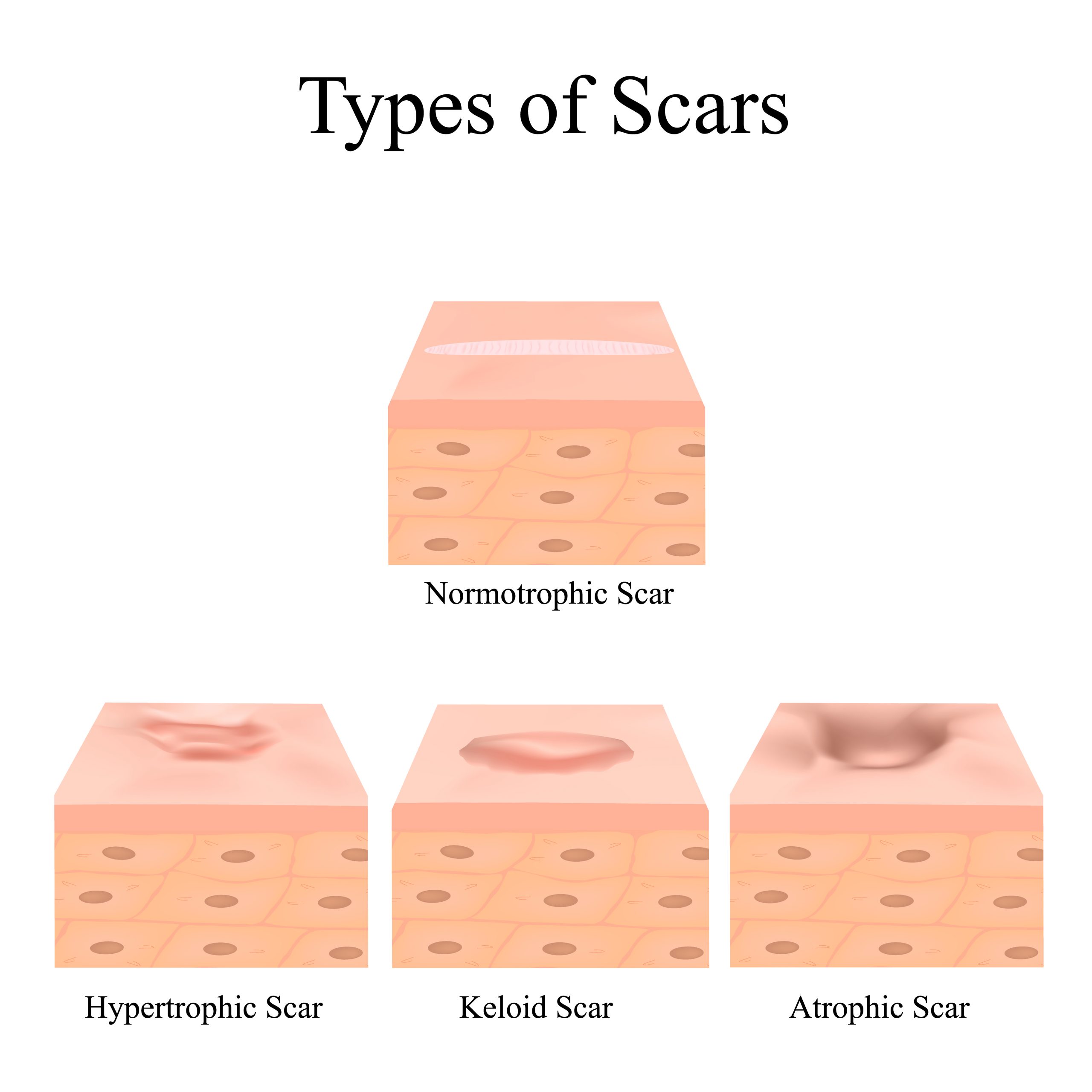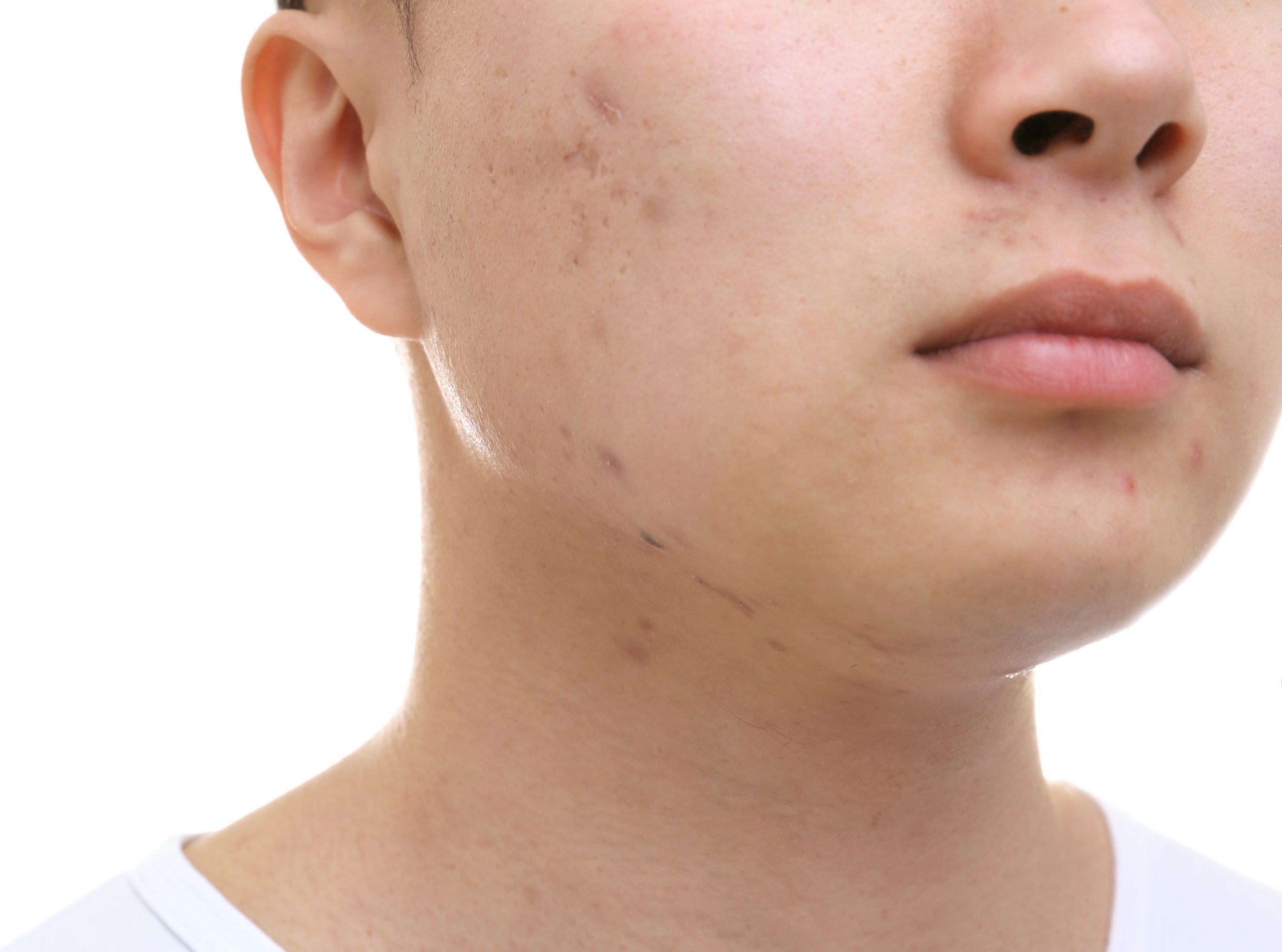Acne is the most common skin condition in the U.S. It’s estimated that around 85 percent of people between the ages of 12 and 24 develop some form of acne, whether mild or severe. Unfortunately, those who experience more severe acne may develop acne scars, which include visible discoloration, pits, or bumps that can last for years. Several types of acne scars can develop due to a variety of reasons. For example, acne scars often form because either too much collagen was produced during the healing process, resulting in raised scars; or perhaps insufficient collagen was produced, resulting in depression or “pit.”
Acne scars are difficult to deal with, and many people are unsure how to treat them. Although they may not go away on their own, there are a variety of treatments available to reduce their appearance.
Different Types Of Acne Scars
Different types of acne scars develop due to various issues caused by acne. The type of acne scarring you have will also determine what kind of treatment is appropriate for you. The main types of acne scars are:
Atrophic Scars
Atrophic scars are the most common of all acne scars. These manifest as depressed areas in the skin, usually caused by a loss of collagen during the healing process. Collagen is a structural protein in the skin and is responsible for providing support to the skin. There are three types of atrophic scars that are identified by their distinct appearance:
- Ice Pick: Ice pick scars are the most common atrophic scars, making up around 60 to 70 percent of atrophic scar cases. They can be identified by their deep, narrow, and V-shaped pitting. They are called “ice pick” scars because they look like an ice pick has punctured the skin.
- Rolling: Rolling scars are the least common type of atrophic scars. They only comprise around 15 to 25 percent of all atrophic scar cases. They are wide and shallow depressions that look like rolling hills.
- Boxcar: Boxcar scars comprise 20 to 30 percent of atrophic scar cases and are characterized by their angular, box-like shape. These scars appear primarily on the cheeks and temples and can be deep. They tend to look similar to chickenpox scarring.
Raised Scars
Unlike atrophic scars, raised scars are caused when collagen is overproduced during the healing process. The excess collagen clumps together, resulting in a bump or ridge in the skin. Common types of raised scars are:
- Hypertrophic Scars: Hypertrophic scars are raised, thickened areas of the skin that can be red or purple in color. They are usually found on the chest, shoulders, neck, or back. Hypertrophic scars are often caused by picking at acne, and they can be quite itchy. These types of scars stay within the area of the skin affected by acne and can regress over time.
- Keloid Scars: Keloid scars are similar to hypertrophic scars, but they differ in that they continue to grow over time and can spread beyond the area of skin affected by acne. They are typically reddish-purple and can be itchy, tender, or painful. They’re also hard and smooth in texture.
Post-Inflammatory Hyperpigmentation (PIH)
PIH can occur due to acne, but it is not technically considered an “acne scar.” It’s more of a discoloration that can remain after the acne has healed. PIH looks like dark red, purple, or brown spots or patches on the skin and is caused by an excess of melanin in the affected area. It can be caused by picking at acne or inflammation, and affects people of all skin tones.
Can Acne Scars Go Away?
Certain types of acne scars can go away on their own. For example, PIH can fade after six to 12 months, although spots may remain. Additionally, some raised scars, such as hypertrophic scars, can regress, although it can take years. On the other hand, atrophic scars are not likely to get better without treatment. In fact, they can become more noticeable over time since less collagen is produced with age.
Although most acne scars won’t go away on their own (and can even worsen with time), that doesn’t mean you’re left with permanent scarring. Treatment options are available for all types of acne scars, no matter how mild or severe.
Acne Scarring Treatments At Natural Skincare & Acne Clinic
It’s worth mentioning that there are lots of different acne scar treatment solutions out there. In fact, even topical treatments may work for milder scarring. However, here at the Natural Skincare & Acne Clinic, we use the following treatments to achieve the best results:
Fractional CO2
Fractional CO2 laser treatment is a revolutionary laser resurfacing procedure that helps reduce the appearance of acne scars and other skin blemishes, such as age spots and wrinkles. The procedure involves using a carbon dioxide laser that removes the outer layers of damaged skin. Fractional CO2 lasers consist of tiny pulses of light that help stimulate collagen production. As such, this treatment is best suited for addressing atrophic scars.
Fractional CO2 is effective because, unlike other laser treatments, it leaves small areas of untreated skin between the treated areas. As a result, the healthy untreated spots provide cells and proteins to help the affected areas heal more quickly. On top of that, fractional CO2 laser treatment requires less downtime; patients generally recover fully within five to seven days of the procedure.
Our fractional CO2 laser treatment is also effective at reducing fine lines, creating a smoother skin tone, reducing brown age spots, refreshing skin texture, correcting skin pigmentation issues (such as PIH), and eliminating sunspots. Results will vary based on the skin’s condition, but the skin should continue improving for up to six months following the procedure as long as you practice proper skin care.
Intense Pulse Light (IPL)
Unlike typical acne scarring, PIH is caused by an excess of melanin. PIH will sometimes go away on its own, although it can take a long time to do so. Other treatment solutions can also work, such as chemical peels and topical solutions. However, for more severe cases, we recommend our IPL treatment.
IPL is a non-invasive, FDA-approved procedure that uses high-intensity pulses of light to target melanin and reduce the appearance of PIH. The only side effects include mild redness and swelling, which happen rarely. To be effective, three to nine treatments are required. It’s also important to note that IPL is only appropriate for light to medium skin types. Patients with darker skin should avoid IPL and should consider chemical peels or microneedling instead.
DermaPen Treatment
DermaPen is our microneedling treatment that helps to reduce the appearance of atrophic acne scars. Microneedling is a procedure that consists of using tiny needles to puncture the skin to create small channels in it. The punctures are tiny wounds, which encourage the body to produce more collagen and elastin. Over time, this helps to reduce the appearance of atrophic acne scars. Additionally, the small channels that are created make it easier for topical products to penetrate the skin, allowing them to be more effective.
DermaPen is a microneedling device that not only treats acne scars but also reduces pore size, fine lines, and wrinkles, hyperpigmentation, and rejuvenates the skin. The DermaPen device consists of 11 automated, spring-loaded micro-needles. The depth of the stamp can be adjusted to better address the patient’s condition, whether they’re being treated for deep acne scars or superficial wrinkles. The design of the DermaPen has resulted in less pain, greater efficacy, and quicker recovery than other microneedling treatments.
Your Acne Scars Don’t Have To Last Forever
Acne scars don’t have to be a permanent reminder of your struggles with acne. At our clinic, we offer a range of treatments that can help reduce the appearance of acne scars and give you a brighter, more confident complexion. From fractional CO2 laser treatments to DermaPen microneedling, there are various treatment options available depending on your condition and desired results. Our team can help you find the best treatment for your needs and work with you to ensure that you get the results you’re looking for. Contact us today to learn more about our acne scar treatments and how they can benefit you.
Ready to get rid of your acne scars for good?


